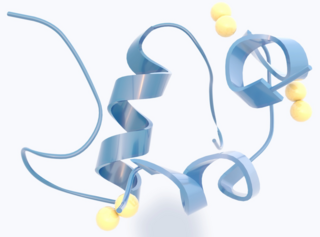
Insulin is a peptide hormone produced by beta cells of the pancreatic islets; it is considered to be the main anabolic hormone of the body. It regulates the metabolism of carbohydrates, fats and protein by promoting the absorption of glucose from the blood into liver, fat and skeletal muscle cells. In these tissues the absorbed glucose is converted into either glycogen via glycogenesis or fats (triglycerides) via lipogenesis, or, in the case of the liver, into both. Glucose production and secretion by the liver is strongly inhibited by high concentrations of insulin in the blood. Circulating insulin also affects the synthesis of proteins in a wide variety of tissues. It is therefore an anabolic hormone, promoting the conversion of small molecules in the blood into large molecules inside the cells. Low insulin levels in the blood have the opposite effect by promoting widespread catabolism, especially of reserve body fat.

John James Rickard Macleod was a British biochemist and physiologist. He devoted his career to diverse topics in physiology and biochemistry, but was chiefly interested in carbohydrate metabolism. He is noted for his role in the discovery and isolation of insulin during his tenure as a lecturer at the University of Toronto, for which he and Frederick Banting received the 1923 Nobel prize in Physiology or Medicine. Awarding the prize to Macleod was controversial at the time, because according to Banting's version of events, Macleod's role in the discovery was negligible. It was not until decades after the events that an independent review acknowledged a far greater role than was attributed to him at first.

Sir Frederick Grant Banting was a Canadian medical scientist, physician, painter, and Nobel laureate noted as the co-discoverer of insulin and its therapeutic potential.

Christian René Marie Joseph, Viscount de Duve was a Nobel Prize-winning Belgian cytologist and biochemist. He made serendipitous discoveries of two cell organelles, peroxisome and lysosome, for which he shared the Nobel Prize in Physiology or Medicine in 1974 with Albert Claude and George E. Palade. In addition to peroxisome and lysosome, he invented scientific names such as autophagy, endocytosis, and exocytosis in a single occasion.
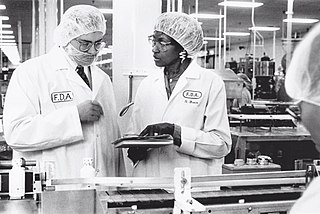
The pharmaceutical industry discovers, develops, produces, and markets drugs or pharmaceutical drugs for use as medications to be administered to patients, with the aim to cure them, vaccinate them, or alleviate the symptoms. Pharmaceutical companies may deal in generic or brand medications and medical devices. They are subject to a variety of laws and regulations that govern the patenting, testing, safety, efficacy and marketing of drugs.

Eli Lilly and Company is an American pharmaceutical company headquartered in Indianapolis, Indiana, with offices in 18 countries. Its products are sold in approximately 125 countries. The company was founded in 1876 by, and named after, Col. Eli Lilly, a pharmaceutical chemist and veteran of the American Civil War.
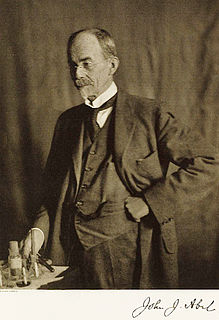
John Jacob Abel was an American biochemist and pharmacologist. He established the pharmacology department at Johns Hopkins University School of Medicine in 1893, and then became America's first full-time professor of pharmacology. During his time at Hopkins, he made several important medical advancements, especially in the field of hormone extraction. In addition to his laboratory work, he founded several significant scientific journals such as the Journal of Biological Chemistry and the Journal of Pharmacology and Experimental Therapeutics.

Tolbutamide is a first-generation potassium channel blocker, sulfonylurea oral hypoglycemic medication. This drug may be used in the management of type 2 diabetes if diet alone is not effective. Tolbutamide stimulates the secretion of insulin by the pancreas.

Eli Lilly was an American soldier, pharmacist, chemist, and businessman who founded the Eli Lilly and Company pharmaceutical corporation. Lilly enlisted in the Union Army during the American Civil War and recruited a company of men to serve with him in the 18th Independent Battery Indiana Light Artillery. He was later promoted to major and then colonel, and was given command of the 9th Regiment Indiana Cavalry. Lilly was captured in September 1864 and held as a prisoner of war until January 1865. After the war, he attempted to run a plantation in Mississippi, but it failed and he returned to his pharmacy profession after the death of his first wife. Lilly remarried and worked with business partners in several pharmacies in Indiana and Illinois before opening his own business in 1876 in Indianapolis. Lilly's company manufactured drugs and marketed them on a wholesale basis to pharmacies. Lilly's pharmaceutical firm proved to be successful and he soon became wealthy after making numerous advances in medicinal drug manufacturing. Two of the early advances he pioneered were creating gelatin capsules to contain medicines and developing fruit flavorings. Eli Lilly and Company became one of the first pharmaceutical firms of its kind to staff a dedicated research department and put into place numerous quality-assurance measures.

Eli Lilly was a pharmaceutical industrialist and philanthropist from Indianapolis, Indiana, United States. Under his vision and leadership, Eli Lilly and Company, founded by his grandfather, grew from a successful, family-owned business into a modern corporation and industry leader. Lilly served as the company president (1932–48), chairman of the board of directors, and honorary chairman of the board.
An insulin analog is an altered form of insulin, different from any occurring in nature, but still available to the human body for performing the same action as human insulin in terms of controlling blood glucose levels in diabetes. Through genetic engineering of the underlying DNA, the amino acid sequence of insulin can be changed to alter its ADME characteristics. Officially, the U.S. Food and Drug Administration (FDA) refers to these as "insulin receptor ligands", although they are more commonly referred to as insulin analogs.

Drug development is the process of bringing a new pharmaceutical drug to the market once a lead compound has been identified through the process of drug discovery. It includes preclinical research on microorganisms and animals, filing for regulatory status, such as via the United States Food and Drug Administration for an investigational new drug to initiate clinical trials on humans, and may include the step of obtaining regulatory approval with a new drug application to market the drug. The entire process – from concept through preclinical testing in the laboratory to clinical trial development, including Phase I–III trials – to approved vaccine or drug typically takes more than a decade.
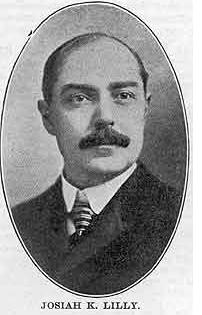
Josiah Kirby Lilly Sr., nicknamed "J. K.," was an American businessman, pharmaceutical industrialist, and philanthropist who became president and chairman of the board of Eli Lilly and Company, the pharmaceutical firm his father, Colonel Eli Lilly, founded in 1876. Josiah, the colonel's sole heir, began working at his father’s company at the age of fourteen. He graduated from the Philadelphia College of Pharmacy and Science and became superintendent of the Lilly laboratories in 1882 and company president in 1898. Under his leadership, the company introduced standardized manufacturing processes, expanded its sales force, and increased its research efforts to develop new drugs. Eli Lilly and Company grew into one of the largest and most influential pharmaceutical corporations in the world, and the largest corporation in Indiana. Lilly’s eldest son, Eli Jr., succeeded him as president in 1932. His younger son, Josiah Jr. ("Joe"), succeeded Eli as company president in 1948. J. K. served as chairman of the board from 1932 until his death in 1948.
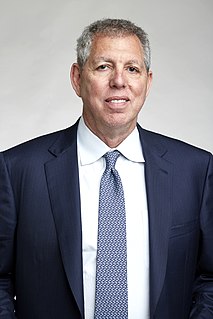
Jeffrey M. Friedman is a molecular geneticist at New York City's Rockefeller University and an Investigator of the Howard Hughes Medical Institute. His discovery of the hormone leptin and its role in regulating body weight has had a major role in the area of human obesity. Friedman is a physician scientist studying the genetic mechanisms that regulate body weight. His research on various aspects of obesity received national attention in late 1994, when it was announced that he and his colleagues had isolated the mouse ob gene and its human homologue. They subsequently found that injections of the encoded protein, leptin, decreases body weight of mice by reducing food intake and increasing energy expenditure. Current research is aimed at understanding the genetic basis of obesity in human and the mechanisms by which leptin transmits its weight-reducing signal.
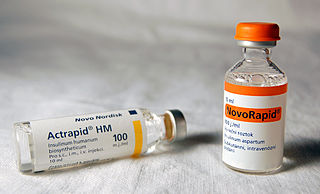
Insulin is a protein hormone that is used as a medication to treat high blood glucose. This includes in diabetes mellitus type 1, diabetes mellitus type 2, gestational diabetes, and complications of diabetes such as diabetic ketoacidosis and hyperosmolar hyperglycemic states. It is also used along with glucose to treat high blood potassium levels. Typically it is given by injection under the skin, but some forms may also be used by injection into a vein or muscle.

The condition known today as diabetes is thought to have been described in the Ebers Papyrus. Ayurvedic physicians first noted the sweet taste of diabetic urine, and called the condition madhumeha. The term "diabetes" traces back to Demetrius of Apamea. For a long time, the condition was described and treated in traditional Chinese medicine as xiāo kě. Physicians of the medieval Islamic world, including Avicenna, have also written on diabetes. Early accounts often referred to diabetes as a disease of the kidneys. In 1674, Thomas Willis suggested that diabetes may be a disease of the blood. Johann Peter Frank is credited with distinguishing diabetes mellitus and diabetes insipidus in 1794.
Keiichi Itakura is an organic chemist and a Professor in the Department of Molecular and Cellular Biology at the Beckman Research Institute at City of Hope National Medical Center.
George Henry Alexander Clowes (1877–1958) was a doctor who worked as the first research director at Eli Lilly and Company. He was responsible for mobilizing Eli Lilly resources to mass-produce insulin, making it available for diabetics beginning in 1923. He was an art collector whose collection of paintings by European Old Masters was donated to the Indianapolis Museum of Art. He and his two sons established The Clowes Fund in 1952 to fund art, education, and social services. The Clowes Award for cancer research was named in his honor.
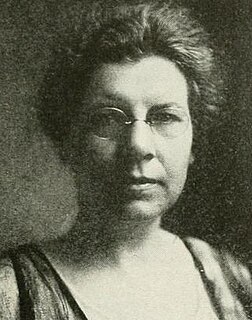
Rena Sarah Eckman was an American dietitian, a founding member and leader of the Academy of Nutrition and Dietetics, and founder of the Pennsylvania Dietetic Association. She was co-author of a 1916 book on a dietary protocol for the treatment of diabetes.
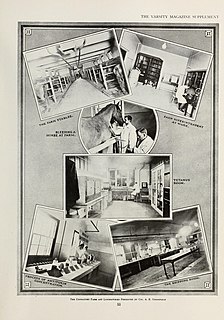
The Connaught Medical Research Laboratories was a non-commercial public health entity established by Dr. John G. FitzGerald in 1914 in Toronto to produce the diphtheria antitoxin. Contemporaneously, the institution was likened to the Pasteur Institutes in France and Belgium and the Lister Institute in London. It expanded significantly after the discovery of insulin at the University of Toronto in 1921, manufacturing and distributing insulin at cost in Canada and overseas. Its non-commercial mandate mediated commercial interests and kept the medication accessible. In the 1930s, methodological advances at Connaught updated the international standard for insulin production.
















